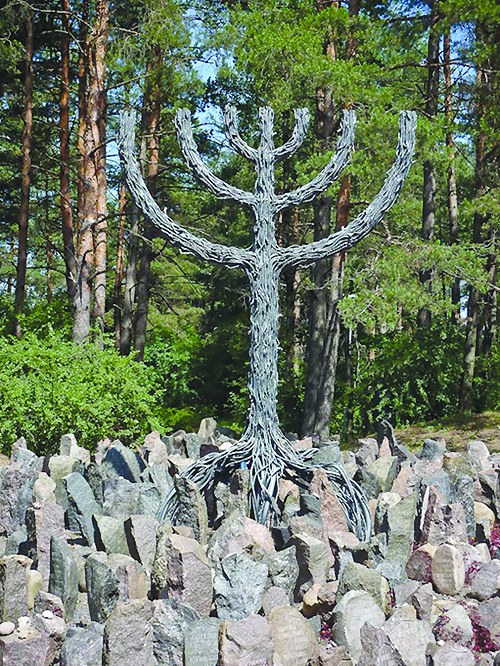A new photo exhibit by Victor Bloomfield depicts remnants of Jewish communities that once thrived in two Baltic states
By DORIS RUBENSTEIN
As a professor of biochemistry at the University of Minnesota, Victor Bloomfield explored the properties of DNA using sophisticated laboratory equipment and theoretical insight. Now that he’s retired, Bloomfield is exploring the building blocks of Ashkenazi Jewish culture using modern digital photography and artistic insight.
Bloomfield took more than 1,400 photographs during a two-week tour of Estonia, Latvia and Lithuania last year and distilled them until he was left with 28 images that best illustrateKaddish for a World Destroyed: Remnants of Jewish Communities in Lithuania and Latvia, a photo essay on display at the St. Paul JCC through Oct. 17.
Kaddish for a World Destroyed was inspired by the interest of Bloomfield’s wife, Dr. Elsa Shapiro (herself a distinguished U of M professor), in her own Jewish genealogy. While Shapiro is of mixed ancestry — maternal Turkish and southern European, and paternal Lithuanian — the show had its genesis while the team was exploring this latter part of her background.
 A memorial at Rumbula Forest near Riga, Latvia. (Photo: Victor Bloomfield)
A memorial at Rumbula Forest near Riga, Latvia. (Photo: Victor Bloomfield)
The Baltic States were central to the development of the Ashkenazic Jewish culture that predominates for U.S. Jews today. Judaism was vibrant there for more than three centuries, then crushed by both the Nazis and Russian Communist rule. While that Jewish world was destroyed, this exhibition shows both its remnants and memorials to the glory of what was, if not a Golden Age of Judaism, at least a beautiful, fragile crystal age.
Opening with a scene from Estonia, the show is optimistic — there is a new synagogue in Tallinn with delicate carvings of the Tree of Life that allow in a light of hope for renewal of the Jewish community there.
The Riga Synagogue in Latvia survived the Nazis due to its strategic location between two buildings, one a church. It suffered greatly, nonetheless. Bloomfield catches its breathtaking art deco art and architecture in restoration; it takes a second and then third glance to catch the spot on the wall that remains dull and dirty, a reminder of the wounds that lie beneath the fresh coats of paint.
Bloomfield and Shapiro acknowledge the government of Latvia for its efforts at recognizing what was lost in terms of lives and culture. Particularly moving are two images of the Rumbula Memorial — twisted metal bars twine to form a menora (or is it a tree with seven branches?) — set among a garden of stones etched with the names of Jewish families who lived in Riga.
Not all the photos are so uplifting and optimistic. The reality is that, particularly in Lithuania, little has been done to preserve or memorialize the remainders of Jewish life that once thrived there. Bloomfield’s testamentary photos to this fact show today’s life in the once vibrant Jewish sections of Shapiro’s ancestral town of Pasvalys in all its bleakness, emptiness and lack of color.
The Jewish communities of the Baltic States are mere shadows of what had been. What does remain has a proud heritage. Nothing captures that better than the photo of the only remaining synagogue in Vilnius. While it is nearly always empty, it holds its head up high and allows the spirits of all who prayed there for so many years to have ample space to soar and welcome those who wish to remember, or say Kaddish.
***
An artist reception, slide show and gallery tour for Kaddish for a World Destroyed: Remnants of Jewish Communities in Lithuania and Latvia, a photo essay by Dr. Victor Bloomfield, will take place 7:30 to 9 p.m. Tuesday, Sept. 14 at the St. Paul JCC, 1375 St. Paul Ave. Photographs will be on sale with proceeds benefiting Jewish Community Action.
The exhibit is on display through Oct. 17. For information, call 651-698-0751 or visit: www.stpauljcc.org.









 A memorial at Rumbula Forest near Riga, Latvia. (Photo: Victor Bloomfield)
A memorial at Rumbula Forest near Riga, Latvia. (Photo: Victor Bloomfield)










Comments 1